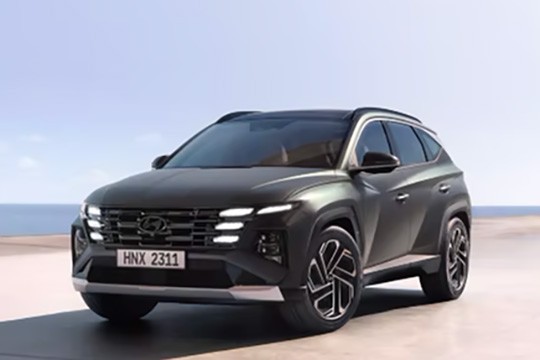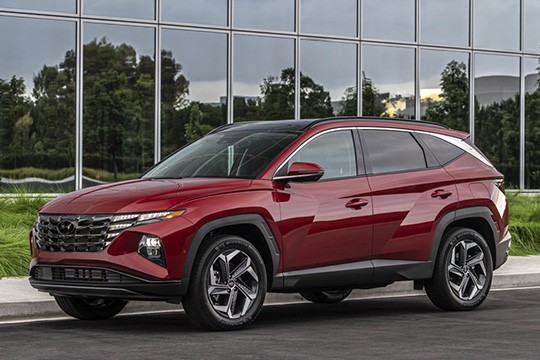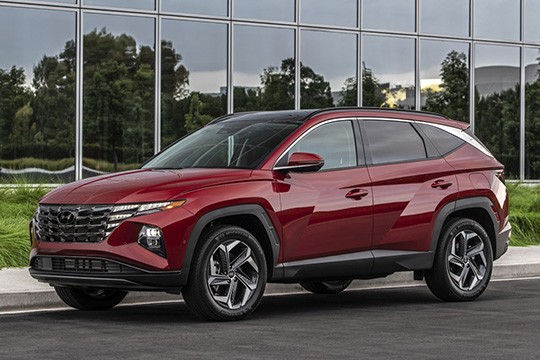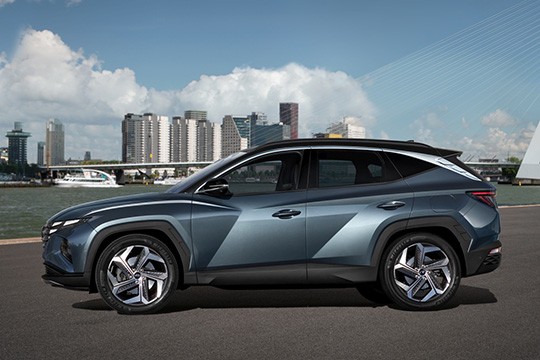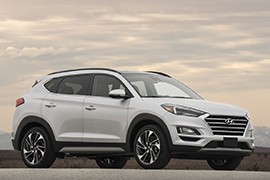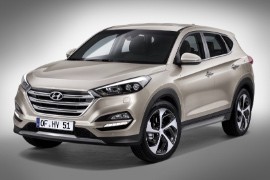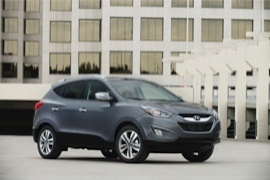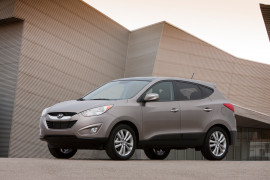HYUNDAI ix35 / Tucson Models/Series Timeline, Specifications & Photos
First production year: 2004
Engines: Gasoline, Hybrid gasoline, Hybrid, Diesel, Ethanol
Body style: SUV (Sports Utility Vehicle)
Hyundai introduced the fourth generation of the Tucson in 2020 and refreshed it in late 2023 for the 2024 model year, adding more European flavor to its compact SUV.
The Korean automaker was eager to get a bigger slice of the compact crossover segment with the Tucson. As a result, it unveiled the fourth generation just five years after introducing its predecessor in 2015, even if the third generation of this nameplate didn’t look outdated. Unfortunately, the fourth generation suffered due to the world pandemic at first and then because of the microchip crisis that plagued the automotive industry for several years. But that didn’t stop the automaker in its tracks; it pushed harder, only this time, it didn’t completely replace the vehicle; it facelifted it.
At the front, the Tucson featured a cascade grille design flanked by the same number of LED lamps mounted on both sides, although redesigned with thin oblique luminescent blades. Like on the non-facelifted version, the headlights were positioned lower on the bumper in separate side scoops. To make the car look meaner and more off-road oriented, Hyundai added a fat skid plate-looking silver trim underneath the apron, even if the Tucson was not a true off-road monster. Still, that created a powerful impression, and customers seemed to like it.
From its profile, the 2024 Tucson showed the same sculptured doors that made the Korean SUV so distinct on the market. The design team didn’t feel an urge to change that, but instead, they made new alloy wheels for the vehicle. Moving on to the back of the vehicle, the 2024 Tucson received a new bumper with an integrated silver skid plate that adorned it. Its shape and size echoed the one from the front.
Still, the most significant changes happened on the inside. The dashboard was completely new and sported two 12.3” screens arranged side by side under the same glass panel. The one fronting the driver showed the speedometer, tachometer, and other relevant information about the car’s status, while the one that sat atop the center stack was the touchscreen for the infotainment system. Furthermore, the center console was redesigned and featured classic rotary knobs for the HVAC system. Another unusual change was for the steering wheel, which sported four dots instead of the H badge. Those four dots correspond to the H letter in Morse code.
Under the hood, the European version of the Tucson got a 1.6-liter turbocharged gasoline engine featuring direct fuel injection, offered in two power levels of 150 PS (148 hp) and 180 PS (178 hp), respectively. Hyundai offered the SUV with either a front or an all-wheel drive system, with either a six-speed manual or a seven-speed automatic (dual clutch). A 1.6-liter full-hybrid was also available.
In 2023, Hyundai refreshed the fourth generation of the Tucson for the 2024 model year, just three years after introducing it on the market.
Trying to survive in a market filled with crossovers was difficult for Hyundai, which offered the Tucson in the compact SUV segment. One of the key elements that helped the Korean automaker keep selling its vehicles was to update them regularly. For instance, the third generation of this nameplate survived on the market for just five years, between 2015 and 2020, before its successor replaced it. In addition, in the U.S. market, besides Honda and Toyota, it had to face stiff competition from local automakers such as Ford and Chevrolet. That’s why, after several tough years caused by the world pandemic and the microchip crisis, Hyundai enhanced the Tucson.
The car’s front featured a similar-looking front fascia as its predecessor, although it was enhanced with a different styling for the ten daytime running lights that flanked the grille. For the refreshed version of the Tucson, Hyundai installed multiple oblique slim blade-style LEDs instead of horizontal, monobloc ones. Lower, on the bumper, the automaker placed the headlights in individual side scoops. A redesigned apron and the skid plate-looking silver trim mounted underneath the bumper enhanced the vehicle’s sporty image, although the Tucson was not a true off-road vehicle.
From its profile, the 2024 Tucson showed the same sculptured doors that made the Korean SUV so distinct on the market. The design team didn’t feel an urge to change that, but instead, they made new alloy wheels for the vehicle. Moving on to the back of the vehicle, the 2024 Tucson received a new bumper with an integrated silver skid plate that adorned it. Its shape and size echoed the one from the front.
Still, the most significant changes happened on the inside. The dashboard was completely new and sported two 12.3” screens arranged side by side under the same glass panel. The one fronting the driver showed the speedometer, tachometer, and other relevant information about the car’s status, while the one that sat atop the center stack was the touchscreen for the infotainment system. Furthermore, the center console was redesigned and featured classic rotary knobs for the HVAC system. Another unusual change was for the steering wheel, which sported four dots instead of the H badge. Those four dots correspond to the H letter in Morse code.
Under the hood, Hyundai installed a 2.5-liter inline-four engine paired with a standard eight-speed automatic transmission for the base version. It was available with either front- or all-wheel drive systems. In addition, the automaker offered a choice of two electrified powertrains: a 1.6-liter HEV and a 1.6-liter PHEV, both being paired with a six-speed automatic. These electrified versions were also available with traction at the front or in all corners.
In 2004, Hyundai introduced the first generation of its compact-segment SUV, the Tucson. By 2020, it reached its fourth generation, which it unveiled in September 2020.
Hyundai introduced the U.S. version of the Tucson in early November 2020 as a 2022 model year. It offered it only with the long-wheelbase version, which was longer, wider, and taller than its predecessor. It also offered some other market-specific features such as the XM Satellite Radio or the fenders' brake-lights.
The 2022 Hyundai Tucson looked more like an SUV coupe than a regular, compact-sized, cross-over vehicle. Its huge grille at the front featured a 3-D design and headlights that showed like those found on some concept-cars. But it was a production model. The front bumper featured two wide scoops on the outer sides and a smaller grille on the apron's bottom.
Inside, Hyundai struggled to offer more for its customers. The flat and low dashboard followed a minimalist design, with a grille-like line placed on its upper side. It was a unique design on the market due to its TFT display for the instrument cluster and the 10.25” full touch-screen on the center stack. The Tucson offered a futuristic look for its time, even though most customers from various brands preferred normal buttons and knobs instead of touch-buttons. Thanks to its longer wheelbase, the U.S. version of the Korean SUV provided more legroom for the rear passengers.
The 2022 Hyundai Tucson offered both a 2.5-liter, direct-injected, and multi-port-injected gasoline engine and a 1.6-liter, direct-injected, turbocharged hybrid, and plug-in hybrid powertrains. They were mated to an 8-speed automatic gearbox, and the power went to all four corners, or just to the front wheels.
The fourth generation of the Hyundai iX35/Tucson was unveiled in mid-September 2020 and it showed no drop in the pace of the Korean car-maker.
With the introduction of the 2021 model, Tucson looked for inspiration elsewhere than the German car-makers. The design was completely different, and it showed some inspiration from the Toyota Rav4 and a touch of SUV-coupe styling.
With its flared fenders, both front and rear, and the sloped chromed line over the windows, the 2021 Tucson looked more like an SUV coupe than just a regular, compact-sized, cross-over vehicle. The huge grille in the front featured a 3-D design and headlights that showed like those found on some concept-cars. But it was a production model. The front bumper featured two wide scoops on the outer sides and a smaller grille on the bottom of the apron.
Inside, Hyundai struggled to offer more for its customers. The flat and low dashboard followed a minimalist design, with a grille-like line placed on its upper side. It was a unique design on the market. The two-dials on the instrument cluster and the big infotainment screen on the center stack showed an advanced look.
The front seats featured medium-sized bolsterings on the outside, while the split-folding rear bench was good for three adults.
The 2021 Tucson was introduced on the market with a turbocharged 1.6-liter gasoline engine, helped by a hybrid system. There was a basic, non-hybrid, version as well. It offered a wide range of manual or automatic traction and up to 7-speed automatic transmissions on the list.
The third generation of the iX35/Hyundai Tucson was revised in 2018. It was unveiled at the New York Auto Show as a 2019 model and received important updates.
Hyundai gained respect on the market due to its reliability factor and the fair prices for its products. The third generation of Tucson faced an ascending sales trend and managed to deliver more than 300.000 units in its first three years on the market. To keep the momentum, the Korean car-company made a facelift for their compact SUV. Depending on the market, the car was named iX35 or Tucson.
On the outside, there was a new “cascading grille”, a new pair of headlights that incorporated the LED daytime running lights. While the DRLs were moved up, the bumper was redesigned. For the N-Line, the front spoiler was more aggressive, with big side air-intakes. In the rear, the reversing lights were smaller and moved onto the tailgate. The rear bumper was redesigned as well.
The interior received a major update to include a newly designed dashboard with lower centrally-placed air vents and a high-mounted head unit display. The center stack, rearview mirror, and instrument cluster have been enhanced as well. The Forward Collision-Avoidance Assist (FCA) and Lane Keeping Assist (LKA) were included in the standard configuration.
Under the hood, there were two new engines included: a 2.0- and a 2.4-liter, which offered 164 hp and 181 hp, respectively. Both versions were mated to the six-speed Shiftronic automatic gearbox.
The new crossover Hyundai Tucson made its appearance in 2015 at the New York International Auto Show. The completely redesigned vehicle featured a fresh, sportier exterior design and an appealing interior. Hyundai made the fuel consumption a top priority for the model and managed to make significant improvements compared to their previous Tucson.
The front design of the Tucson featured LED Daytime Running Lights, LED twin-projector headlights and the Hyundai’s specific hexagonal-shaped grille. The car’s wheelbase was increased thus the interior flexibility and the ride experience were enhanced. Buyers could opt for 19-inch alloys, a feature that was not offered for the Tucson before the 2016 model.
The interior was refined to offer a premium experience, with a leather-wrapped instrument panel and soft-touch materials used for the touch points.
The base models were equipped with a 2.0-liter engine, developing 164 hp and 151 lb.-ft of torque. The engine was mated to a 6-speed automatic transmission that also offered a manual shifting mode (SHIFTRONIC).
The Tucson was offered with an optional all-wheel-drive system incorporating Hillstart Assist and Downhill Brake Control to help the drivers when necessary.
The Blue Link system integrated for 2016 offered enhanced safety and infotainment: start/stop feature, remote door lock/unlock, car finder, stolen vehicle recovery and others, features that could be controlled via a device supporting Android.
Hyundai introduced a facelifted version for the second generation of the Tucson in 2013 for the 2014 model-year and improved both the look and the powertrains available for its compact crossover.
While the first generation of the Tucson was a mundane-looking vehicle but still dependable, the second generation came in 2009 as a big surprise for anyone thanks to its bold styling and improved features. Four years after the launch of the LM generation, the car received a facelift that brought more features and improved powertrains.
With the facelifted version, Hyundai dared more and amplified the angular look of the vehicle's headlights. In addition, there were new projector lamps and LED daytime running lights installed. The front fascia was also enhanced by a new bumper that sported enlarged foglights compared to the non-facelifted version. At the back, the change was even more visible due to the introduction of LED taillights. In addition, Hyundai installed panoramic glass as an option on the roof, together with roof rails.
At 101.9 cubic feet (2.885 liters), the Tucson offered the most spacious interior room on the market in its segment. But that didn't stop the Korean carmaker from improving it and adding more features, such as the two-stage reclining rear bench. At the front, the occupants could enjoy the illuminated cupholders. At the same time, the driver was spoiled with the pale-blue backlit of the instrument cluster. Moreover, Hyundai installed a climate control with an ionizer that could kill germs and keep the interior air fresh from outside odors.
Under the hood, the most significant upgrade was the 2.0-liter GDI (Gasoline Direct Injection) engine mated to a six-speed automatic gearbox. The Tucson was available with either a front or all-wheel drive system, depending on the options.
The second generation of the Hyundai Tucson was unveiled at the 2009 Frankfurt Motor Show and it was a completely new approach for the SUV market when compared with its predecessor.
While the world global economy was still in recession, the iX35/Tucson took advantage of a newly developed platform and stormed the market. The switch toward the SUV segment was already in customer's minds and the Hyundai product came in a good moment. Priced below the established SUVs from the premium car-makers and with a small competition on the market, it was a winning solution for Hyundai/Kia, despite the bad economic moment.
On the outside, the Tucson left its predecessor in the dust with a bold and young look. The new design language with fluid lines and sharp angles took over the classic appearance of its predecessor. The raked A-pillar, similar to a compact-sized vehicle, and the hatchback-style tailgate made the Tucson/iX35 an instant hit. On top of that, the alloy wheels were fitted as standard from the base trim level.
Inside, the updated dashboard, high seating position, and flat rear floor improved the comfort for the passengers. A high center console and a neat center stack were part of a well-organized dashboard. The instrument cluster took the blue lights from the Genesis range, to display key information.
The iX35 was available with a choice of gasoline and diesel engines, with front or all-wheel-drive. It was available with a 5- or 6-speed manual gearbox, or a 6-speed automatic.
Hyundai released the Tucson in 2005 as an entry-level SUV placed below the Santa Fe.
Based on a heavily modified Elantra platform, the Hyundai Tucson featured a shorter length, a longer wheelbase, and a greater width than its key competitors.
Aesthetically, the small SUV had a contemporary rugged design with big-eye headlights and quirky character lines that made it recognizable as a Hyundai.
Inside, the interior was functional and simple, with easy-to-read gauges and intuitively placed controls. However, it featured some low quality plastics here and there. The comfortable seats were available with a cloth or optional leather upholstery.
While not class-leading, the Tucson offered a decent cargo space of 642-liters (22.7 cu ft).
Fit for all weather conditions thanks to the four-wheel-drive system, the Tucson also performed well in mild off-roading, tackling mud and snow without too many problems thanks to its 199mm (7.8") ground clearance.
Serious rock climbing was not a job for Tucson due to the lack of a low-range transfer case.
The 2005 Hyundai Tucson was available in three trim levels: GL, GLS, and GLX. Hyundai equipped the Tucson with standard front side impact airbags, side curtain airbags, stability control, traction control, and antilock brakes. It was also the least expensive SUV fitted with standard side airbags and an electronic stability control system.
